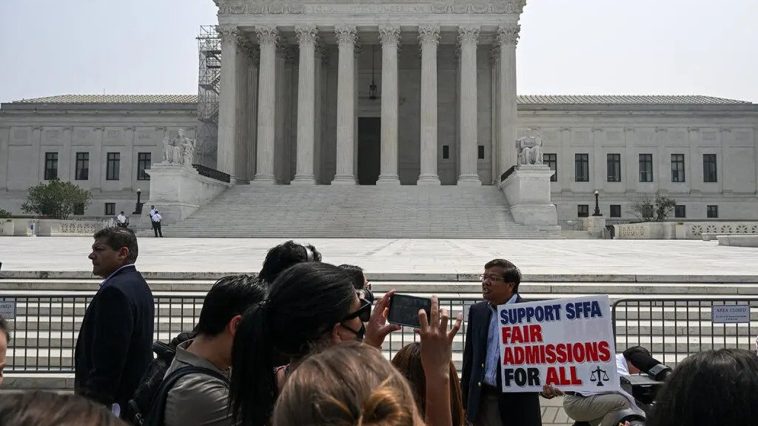LISTEN HERE:
In a significant victory credited to conservative activists, the Supreme Court recently invalidated affirmative action programs at the University of North Carolina and Harvard. This ruling marked an end to the systematic consideration of race in the admissions process, as the court deemed both programs in violation of the Constitution’s Equal Protection Clause.
Prominent conservatives have wholeheartedly embraced the decision, emphasizing the importance of a ‘colorblind’ Constitution. On the other hand, liberals have condemned the ruling, asserting that affirmative action is an essential tool to address historic race discrimination.
This verdict effectively overturned the court’s previous ruling in 2003, known as Grutter v. Bollinger, which had allowed race to be considered as a factor in admissions due to the importance of maintaining diverse campuses.
The court’s latest ruling, however, discarded decades of precedent, including a 1978 ruling that limited the consideration of race in university admissions as a means to combat historical discrimination against Black individuals and other minorities.
Chief Justice John Roberts, in the majority opinion, didn’t explicitly declare the former precedents overruled. However, Justice Clarence Thomas, one of the court’s conservative justices and the second Black justice to serve, expressed in a concurring opinion that the Grutter case was essentially ‘overruled in practice.’
Chief Justice Roberts contended that both affirmative action programs lacked clear objectives that justify the use of race.
He argued that they unavoidably employed race in a negative manner, involved racial stereotyping, and lacked meaningful end points. Justice Thomas, an outspoken critic of affirmative action, further criticized the programs, characterizing them as ‘aimless, race-based preferences designed to engineer a specific racial composition among entering classes.’
This ruling exemplifies the court’s commitment to conservative legal activism, considering its current conservative majority of 6-3. It follows the landmark 2022 decision overturning Roe v. Wade, the seminal ruling that established the right to abortion in 1973.
While the most selective universities, with highly competitive admissions, will bear the greatest impact, the decision affects the broader future of racial diversity programs, extending its influence from higher education to K-12 schools and potentially to challenges against diversity programs in the workplace under Title VII of the Civil Rights Act.
However, Chief Justice Roberts did leave some room for colleges to consider race in certain circumstances, such as when an individual has personally experienced racial discrimination.
In such cases, the student must be treated based on their individual experiences, rather than their race. Additionally, the ruling doesn’t address the consideration of race in military academies, leaving this matter open for further deliberation.
The Biden administration had warned that restricting affirmative action would have detrimental effects on the military, which relies on well-qualified and diverse officers educated at military academies like West Point, in addition to civilian universities.
The extent of flexibility that colleges will have in developing race-neutral programs to foster diverse student bodies remains unclear. Critics of affirmative action argue that these policies often fail and can even lead to declines in Black and Hispanic enrollment.
They point to examples in the nine states where affirmative action is banned, which they believe demonstrate that considering race is not essential to achieving diversity.
The reach of this ruling extends beyond higher education, potentially influencing practices in K-12 schools and placing pressure on colleges to devise effective race-neutral programs to foster racial diversity.
Furthermore, it could pave the way for future challenges to diversity programs in employment, as similar arguments may be made under Title VII of the Civil Rights Act.
Affirmative action, introduced to rectify historical discrimination, has long been a contentious issue. Educational institutions and corporate America have championed it as vital for diversity, while conservatives have decried it as contrary to the principle that racial equality means treating all races equally.
The group Students for Fair Admissions, led by conservative activist Ed Blum, brought both challenges to the Supreme Court. Following the ruling, Blum declared, ‘The polarizing, stigmatizing, and unfair jurisprudence that allowed colleges and universities to consider a student’s race and ethnicity, determining their admission or rejection, has finally been contradicted.’
The legal debate surrounding affirmative action remained unresolved after a fractured Supreme Court ruling in 1978, which prohibited racial quotas but left room for some consideration of race. In 2003, the court reluctantly permitted certain affirmative action programs in the Grutter ruling.
When the court last ruled on affirmative action in 2016, it narrowly upheld the admissions policy of the University of Texas at Austin by a 4-3 vote, with conservative Justice Anthony Kennedy casting the deciding vote. After President Donald Trump appointed three conservative justices, the court tilted further to the right.
The recent appointment of Justice Jackson by President Joe Biden maintained the ideological balance, as she succeeded liberal Justice Stephen Breyer.
The challenges brought by Blum’s group argued that race should not be considered in college admissions, asserting that it violated both Title VI and the Constitution. They claimed that the UNC and Harvard admissions policies discriminated against white and Asian applicants, respectively. However, the lower courts had ruled in favor of the universities.
Advocates for these policies, including the Biden administration, civil rights groups, businesses, and former military leaders, defended them by emphasizing the distinction between excluding someone based on race and seeking campus diversity.
The universities themselves argued that race is just one factor among many in their comprehensive evaluation of each applicant.
UNC Chancellor Kevin Guskiewicz expressed the university’s unwavering commitment to fostering diversity and bringing together talented students from diverse backgrounds and perspectives.
Harvard leaders also conveyed their dedication to core principles that rely on a diverse community to facilitate transformative teaching, learning, and research. Both universities now face the challenge of aligning their policies with the court’s new precedent while preserving their fundamental values.


